 Today, the Commission published the 2017 edition of its yearly Employment and Social Developments in Europe (ESDE) review.
Today, the Commission published the 2017 edition of its yearly Employment and Social Developments in Europe (ESDE) review.
This year’s edition confirms positive labour market and social trends and continued economic growth. With over 234 million people having a job, employment has never been as high as today in the EU and unemployment is at its lowest level since December 2008. Since 2013, 10 million jobs have been created in the EU. But looking beyond the overall social and economic progress, evidence shows that there is a particularly heavy burden on younger generations: they tend to have more difficulties in finding a job and are more often in non-standard and precarious forms of employment including temporary contracts, which may lower their social protection coverage. They are also likely to receive lower pensions, relative to wages. This is why the 2017 ESDE review focuses on intergenerational fairness: we need to make sure that all generations benefit from the current positive economic trends.
Commissioner for Employment, Social Affairs, Skills and Labour Mobility, Marianne Thyssen, commented: “This annual review shows once again that we are firmly on the path towards more jobs and growth. However, today’s young and their children may end up worse off than their parents. This is not what we want. Swift action is needed. With the European Pillar of Social Rights we want to preserve and improve our social standards and living conditions for future generations.”
The report shows that despite steady improvements in living standards in the EU, young people do not equally benefit from this positive evolution compared to the older generations. Moreover, younger age groups’ share in income from work has decreased over time. Such challenges are affecting younger people’s household decisions, including having children and buying a house. This may in turn have negative consequences on fertility rates and, consequently, on the sustainability of pension systems and growth.
In addition, the working age population is expected to decline by 0.3% every year until 2060. This means that a smaller work force will need to ensure we keep on the current growth path. It also means that at the same time, a smaller number of contributors will pay into pension systems – often with lower and/or irregular contributions as they will not be corresponding to full-time and/or standard work- while more pensioners will depend on them. Today’s young workers and future generations therefore seem to face a double burden stemming from demographic change and the need to ensure pension systems’ sustainability.
What next?
Policy makers can prepare for and mitigate these evolutions in several ways. First of all, we need to make full use of our human potential on the labour market, by activating and equipping with the right skills all generation groups and making sure there is a proportionate link between the duration of working lives and life expectancy. Policy efforts resulting in higher fertility and efficient migration management can also help, as well as supporting innovation and increasing efficient spending on investment in young and old people’s skills and their education.
Lastly, social partners can make a major contribution to bridging the gap between younger and older workers to promote a fairer labour market for both. This includes promoting lifelong learning, the provision of social protection benefits and contributing in the design and implementation of employment protection legislation and active labour market policies.
Background
The annual Employment and Social Developments in Europe review reports on the latest employment and social trends, and reflects on upcoming challenges and possible policy responses. It is the European Commission’s main report to provide evidence and analysis and to review trends and upcoming challenges on the labour market.
There are many concrete examples of how the Commission aims at addressing challenges raised in the yearly ESDE reports. The European Pillar of Social Rights, for instance, serves as a compass towards fair and well-functioning labour markets. It aims to ensure that our social models are fit for the 21st century, especially in the context of ageing societies and digitalisation. Its accompanying initiatives, such as the social partners’ consultations on modernising labour contracts and access to social protection, aim at ensuring clear working conditions and social protection also for those in non-standard types of employment.
Investing in people and empowering them to harness quality job opportunities is exactly at the heart of the ‘New Skills Agenda for Europe’. It has the aim to support the development of citizens’ skills to prepare them for the changing world of work.
The Commission’s efforts to decrease unemployment in general and youth unemployment in particular are bearing fruit. There are 1.8 million fewer young unemployed in the EU and 1 million fewer young who are not in employment, education or training (the so-called NEETs) since the peak of the crisis in 2013. With the prolongation of the Youth Guarantee, the financial top-up of the Youth Employment Initiative and the recently presented initiative to further Invest in Europe’s Youth, the Commission aims at maximising young people’s chances on the labour market.
Source: europa.eu
 Government of the Republic of Serbia
Government of the Republic of Serbia















 pdf [271 KB]
pdf [271 KB]
Leave a Comment